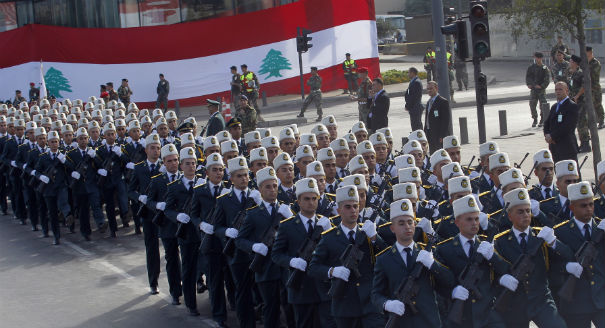For three years, the Syrian war has fueled anti-army grievances among many Lebanese Sunnis, the large majority of whom support the revolution and claim the Lebanese military has grown too close to Hezbollah, a key backer of the Assad regime. In response to growing security threats, the army and security forces launched a new plan to restore the rule of law by setting up checkpoints and increasing raids along the Syrian-Lebanese border. The plan, which relies on increased cooperation with Hezbollah, has improved the country’s overall security and reduced tensions between the Sunni community and the military. But recent attacks—including the June 23 suicide bombing in a Shia suburb of Beirut, the June 20 attack in the Bekaa Valley, and the May 20 attack in Tripoli—underline that relations between Sunnis and the army remain strained. The security plan is only a short-term solution that highlights the lack of a long-term effort to rebuild Sunni trust in the country’s military.
The Lebanese Armed Forces (LAF) faces a daunting balancing act, cracking down on terrorism while maintaining the perception of neutrality that emerged following former Prime Minister Rafik Hariri’s assassination in 2005. This neutrality has been challenged by the protracted conflict in Syria and the army’s reactions to Lebanese participation by both Hezbollah and jihadi fighters. Given Hezbollah’s influence, the Lebanese army has been unable to do much about its involvement in the Syrian war, fearing a domestic backlash if they arrest Hezbollah militants heading to Syria. Yet the military is able to crack down freely on Sunni jihadis because they do not have the support of any major Lebanese political force. Also unlike jihadi fighters, Shia fighters don’t constitute as much of a threat to the state. They belong to a well-structured and well-organized militant group and adhere to a rigid structure and chain of command. Sunni jihadis, however, are unruly and do not seem to follow the leadership of the Sunni community. Many see the Lebanese state as a source of oppression and have accused the military institution of applying double standards in its crackdown on the flow of Lebanese fighters to Syria.
This growing enmity between the LAF and Lebanese Sunnis predates the Syrian conflict. In 2007, the LAF fought a three-month war against Sunni jihadi group Fateh al-Islam in the Palestinian camp of Nahr el-Bared, in which over 150 soldiers were killed. The army’s resolve in fighting this predominantly Sunni terrorism threat only strengthened after June 2013, when at least eighteen soldiers died in clashes in Sidon between its forces, backed by Hezbollah, and followers of fiery anti-Hezbollah Sunni cleric Ahmad al-Assir. The fact that Hezbollah militants fought alongside Lebanese soldiers during these clashes was a double-edged sword. This shared hardship created a stronger bond with Hezbollah but reinforced Sunni suspicions that the army and security services were becoming dominated by the militant Shia organization. Hezbollah-LAF ties reached new heights after a wave of bombings in late 2013 into early 2014 targeted Shia neighborhoods in Beirut and along the Lebanese border. The bombings—which were claimed by Jabhat al-Nusra and its branch in Lebanon, the Abdullah Azzam brigades, as retribution for Hezbollah's involvement in Syria—killed both Shia civilians and Lebanese soldiers.
Facing greater threats from the escalating war in neighboring Syria, the army sought aid from Hezbollah, especially over the past few months. By 2013, the Lebanese army was exchanging valuable security information with Hezbollah that allowed it to respond effectively to a number of threats. According to an army source, the shared intelligence contributed to the army’s successful dismantling of a terror ring responsible for dozens of attacks in February and March.1 However, Sunni fears of the LAF’s bias toward Hezbollah were made worse by the latter’s statement that its involvement in Syria is to protect Lebanon against the takfiri threat from jihadis (a foe that the army had fought for several years). This narrative has allowed both the party and the army to identify Lebanese and Syrian jihadis as a common enemy.
The LAF’s makeup is designed to represent all communities, reflecting the country’s confessional system. However, in recent years, the LAF’s higher ranks have essentially been left to the Christians and Shia, who are currently allied under an agreement between Michel Aoun, head of the Free Patriotic Movement, and Hassan Nasrallah, head of Hezbollah. The army’s unofficial promise of non-partisanship is upset when it is perceived to favor one community over another. Recently, terrorist groups have been attempting to capitalize on the Sunnis’ growing hostility toward the LAF: Jabhat al-Nusra, for instance, encouraged Lebanese Sunnis to defect from the LAF in March. Such calls could allow al-Qaeda affiliated groups to exploit the military’s vulnerabilities. Only two years ago, Tawfiq Taha, a Palestinian member of the Azzam Brigades, was able to recruit members of the military in planning terror attacks on army barracks.
To many Lebanese, the LAF’s legitimacy is not just rooted in its ability to fight, but in how impartial it can be in times of internal strife. The army’s cooperation with Hezbollah has allowed them to conduct raids for wanted fugitives in several Shia villages in the Bekaa Valley, including the April 10 operations in Brital, which would have otherwise been off-limits to the LAF. Such operations may have reduced the perception of inequity felt by Sunnis, but the military’s perceived closeness to Hezbollah will continue to heighten confessional and sectarian fears in the absence of a true dialogue between state institutions and local Sunni communities.
Mona Alami is a French Lebanese journalist who writes about political and economic issues in the Arab world. She is a regular contributor to Sada.
1. Interview with the author. ?






.jpg)
